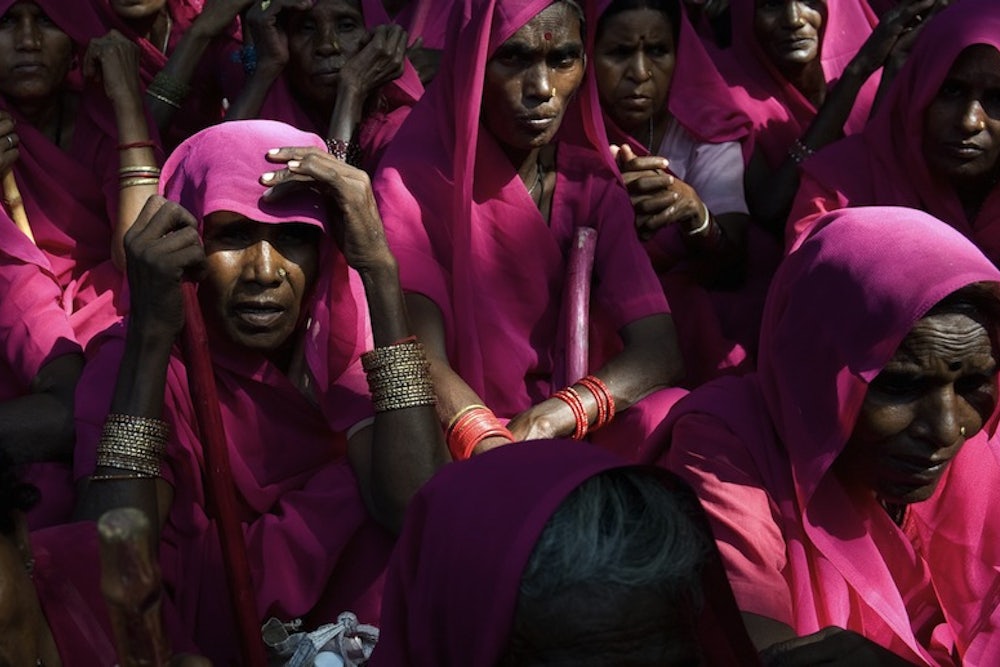If India’s largest state, Uttar Pradesh, “were a country,” journalist Amana Fontanella-Khan states in the opening chapter of Pink Sari Revolution: A Tale of Women and Power In India, “it would be the fifth most populous one in the world. But it would also be the poorest; food scarcity there is more severe than in Sub-Saharan Africa.” Lawless and corrupt, it is the “home of some of the country’s most notorious bandits,” with a crooked police force that locals want protection from rather than the protection of. Elected representatives bring no relief: Between 2002 and 2007, half the ruling party's electoral candidates “had criminal charges pending against them or had been convicted.”
Women are among the worst-off in this impoverished state. “We sing songs when boys are born,” says Sampat Pal, the heroine of Pink Sari Revolution, “but for girls no one sings.” While women in India’s urban centers join the workforce, marry and otherwise enjoy relationships on their own terms, there are still vast swathes of India where conservative tradition reigns. There, some blame “Western” ideas—namely, the emancipation of women—for high rates of sexual assault. In the city of Aligarh, in June, a woman was beaten to death for allowing her daughter to wear jeans. While child marriage is illegal, more than one-third of the world’s child brides live in India, and scarcely a day goes by without a grisly tale of murder resulting from a disappointing dowry or inadequate modesty. While throngs of ordinary citizens poured onto Delhi’s streets in January to protest the brutal gang-rape of a student on a bus, small town India is still another world.
The Pink Sari Revolution is a 20,000-strong troop of women activists headed by Sampat Pal that aims to change this sorry state of affairs. While they’re often depicted brandishing canes and billed as kick ass vigilantes, Pink Sari Revolution gives a softer impression—that their mission is focused more on raising awareness of women’s rights and providing women with legal counsel than on beating up bad husbands. Pal’s singular story is Khan’s focus, however, and in emphasizing the life of one woman, she sacrifices the possibility for a deeper understanding of the operations of the Pink Gang and the change they might foment.
Sampat Pal may not seem the most likely candidate to spearhead an enormous women’s movement. Without formal schooling and married at the age of twelve, she had few of the resources one might expect of a national leader. (But given the countless number of highly educated, privileged Indian women only too willing to enter a predetermined role as a subordinate, what does likelihood have to do with anything, really?) What Pal has is a razor-sharp mind, a burning sense of social justice, and courage. Her favorite uncle, the only person in her family with a college degree, treated her “like a man” she says. “If someone hits you, hit them back” he told her, and that’s precisely what she started doing—on behalf of those who wouldn’t or couldn’t.
In her early twenties, having already had five children with her fairly uninspiring husband, Pal decided that she wants more control over her life. She put together enough money to buy a sewing machine by stealing grain from her own store and selling it back to the grocer for a lower sum. (She told her husband she found the money lying on the road.) Emboldened, she then decided she wanted to join a local, cash-strapped NGO and work for the awareness of women’s rights. Her husband kicked up a fuss, and so she fibbed; when an admirer unwittingly revealed her double-life, her resolve only increased: “I decided either I will become weaker than him or stronger than him." She went on to persuade local women to pool money in order to help women who find themselves in trouble. Borrowing money from a friend, she bought some cheap polyester saris as a uniform for these women. (They’re pink because every other color is already associated with a political party or a religion in India.)
While Pal often placed herself directly in danger’s path, the closest she comes in this book to an actual assassination attempt is unrelated to her campaign for women’s rights. A crew of outraged men show up at her door, sent to kill her after she is spotted sharing a drinking vessel with a member of a lower caste. She packs her things, gathers her children, and takes the first bus out of town. She starts over, recruiting more women, taking on more cases, and ultimately attracting the attention of the President of India’s ruling political party. The book ends with Pal determined to run for office.
While this recounting of Pal’s life makes for a brisk read, it ultimately feels like a missed opportunity. The Pink Sari Revolution presents events but doesn’t aim for theories or larger ideas. Once you’ve read it, there’s not much to chew on; it boils down to a few years in the life of one woman, inspiring though she is. This is additionally disappointing since the book is billed (in its subtitle) as “A Tale of Women and Power In India.” There are legions of women standing up for their rights in India, through women’s rights organizations or merely by deciding to work. But The Pink Sari Revolution neither alludes to these movements nor provides a portrait of the way this singular organization is changing things. Though limited in its scope, it is, however, a fine tribute to a remarkable woman, a close look at an India that still exists beneath the economic boom of recent years, and a rousing reminder that formidable will can make a difference.
